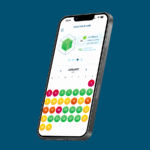Bones, beliefs, and behavior: Tackling the adherence gap in osteoporosis care
Osteoporosis is a silent disease—until it isn’t. A fracture from a simple fall or even a cough can be the first sign.1 For many patients, that fracture changes everything. Hospital stays, surgeries, loss of independence—it’s all too common.2 Yet the tragedy is that much of this is preventable.3
Treatments have been shown to reduce the risk of hip fracture by up to 40%, vertebral fractures by 30-70%, and some medications reduce the risk for non-vertebral fractures by 15-20%.4 These therapies have been shown to work in large clinical trials and are backed by decades of research. So why is it that so many patients stop taking them?
That’s the puzzle at the heart of osteoporosis care today. Medication adherence—whether patients take their medicine as prescribed and for long enough—is one of the biggest challenges in preventing fractures.5 And it’s not a simple fix.
The scale of the problem
About 20–30% of patients do not initiate a treatment after a prescription for oral bisphosphonates. Data from a recent review including 124 studies suggests that about 40% of patients discontinue bisphosphonates at 1 year nonadherence. When patients stop taking their medication, the consequences are serious. fracture risk increased by approximately 30% with non-adherence and by 30 to 40% with non-persistence. This isn’t a minor issue—it’s a major clinical risk.6 Hip fractures cause the most morbidity with reported mortality rates up to 20-24% in the first year after a hip fracture.7
Poor adherence with osteoporosis medications results in around a 50% reduction in the potential benefits observed in clinical trials and a doubling of the cost per quality-adjusted life year (QALY) gained from these medications.8
It also has an economic impact. In Europe alone, the overall cost of fragility fractures was estimated at €37.5 billion (2017) and set to increase by 27% by 2030,7 and nonadherence is a key contributor.8 These costs are expected to rise with an aging population.9
Why patients stop—it’s not just forgetfulness
As healthcare professionals, we often assume that patients who stop their medications either forgot or didn’t understand the instructions. But adherence is much more complex. It’s about beliefs, fears, daily routines, and how people live their lives.10
Many patients don’t “feel” their osteoporosis. Unlike symptomatic conditions, there are no obvious symptoms. If the medication doesn’t make them feel better—and especially if it causes side effects, even rarely, patients may not see the point in continuing.11
Cost, of course, can be another barrier—particularly in health systems with co-pays or gaps in coverage.12 Even small costs can reduce adherence over time.13
And then there’s complexity. Some osteoporosis medications, such as oral bisphosphonates, come with strict instructions: take on an empty stomach, stay upright for 30 minutes, avoid food or drink.11 These protocols can interfere with daily life, making it easier to skip a dose—and eventually, to stop altogether.6
What works: Behavioral science and smart technology
To improve adherence, we need to start thinking differently. This isn’t just a clinical problem—it’s a behavioral one.14
Behavioral science teaches us that people don’t always make rational choices, especially when the benefit is far in the future and the burden is immediate.14 Taking a pill every week to prevent a fracture five years from now isn’t intuitive.11 But we can help patients by making adherence easier and more rewarding.
One proven approach is simplifying the regimen. Studies have shown that patients are more likely to stay on medications that require less frequent dosing. Injectable therapies given every six months, or infusions given once a year, often result in much higher adherence rates.15,16
Technology can also help. SMS reminders, app-based tracking, and digital pill dispensers have all shown promise.17,18
Fracture liaison services (FLS)—coordinated programs that follow patients after a fracture—are another success story. These services ensure that patients receive not just the prescription, but the follow-up and education they need. Patients in FLS programs are more likely to start and stay on osteoporosis medications.19
Motivational interviewing, shared decision-making, and tailored patient education may also make a difference, as it has shown promising results in multiple chronic conditions.20 When patients feel heard and involved in their care, they’re more likely to follow through.21
What HCPs can do differently
Clinicians are often focused on diagnosis and prescribing. But with osteoporosis, the job doesn’t end there. Following up—asking if patients are still taking their medication, and if not, why—is just as important as writing the initial prescription.20
It helps to speak in plain language. Explain what osteoporosis is, what a fracture can mean for independence and quality of life, and how the medication works.3 Acknowledge the side effects and the fears but put them in perspective.11
Promising interventions include patient education with counselling, adherence monitoring with feedback and dose simplification including flexible dosing regimen.5
And when patients do stop, don’t blame them. Ask what got in the way and offer alternatives.21 Adherence is not a fixed trait—it’s something we can nurture.21
Looking forward
Medication adherence in osteoporosis isn’t just a patient problem. It’s a system problem, a communication problem, and a design problem. But it’s also a solvable one.6,21
If we blend the power of effective medication with the insights of behavioral science and the reach of digital technology, we can help more patients stay on treatment—and stay fracture-free.14,18
This isn’t just about bones. It’s about lives, independence, and the belief that simple changes—taken seriously—can prevent serious harm.
This article was written with the assistance of generative AI technology and reviewed for accuracy.













